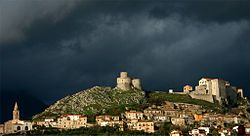- Montesarchio
-
Montesarchio — Comune — Città di Montesarchio 
Coat of armsLocation of Montesarchio in Italy Coordinates: 41°3′40″N 14°38′0″E / 41.06111°N 14.633333°ECoordinates: 41°3′40″N 14°38′0″E / 41.06111°N 14.633333°E Country Italy Region Campania Province Benevento (BN) Frazioni Varoni, Cirignano, Tufara Valle Government - Mayor Antonio Izzo Area - Total 26.3 km2 (10.2 sq mi) Elevation 300 m (984 ft) Population (2007) - Total 13,542 - Density 514.9/km2 (1,333.6/sq mi) Demonym Montesarchiesi Time zone CET (UTC+1) - Summer (DST) CEST (UTC+2) Postal code 82016 Dialing code 0824 Patron saint Saint Nicholas Saint day 6 December Website Official website Montesarchio (Latin: Caudium; Greek: Καύδιον) is a comune in the Province of Benevento, Campania, southern Italy. It is located 18 km south-east of Benevento in the Valle Caudina at the foot of Monte Taburno. The commune was granted the official status of City (Città) by a presidential decree of 31 July 1977.[1].
Contents
History
Ancient
Montesarchio is the site of ancient Caudium, an ancient city of Apulia et Calabria, situated on the road from Beneventum (modern Benevento) to Capua. It seems probable that it was in early times a place of importance, and the capital or chief city of the tribe called the Caudini; but it bears only a secondary place in history. It is first mentioned during the Second Samnite War, 321 BCE, when the Samnite army under Gaius Pontius encamped there, previous to the great disaster of the Romans in the neighbouring pass known as the Caudine Forks (Livy ix. 2); and again, a few years later, as the head-quarters occupied by the Samnites, with a view of being at hand to watch the movements of the Campanians. (Id. ix. 27.) The town of Caudium is not mentioned during the Second Punic War, though the tribe of the Caudini is repeatedly alluded to. Niebuhr supposes the city to have been destroyed by the Romans, in revenge for their great defeat in its neighbourhood; but there is no evidence for this. It reappears at a later period as a small town situated on the Appian Way, and apparently deriving its chief importance from the transit of travellers (Hor. Sat. i. 5. 51; Strabo v. p. 249): the same causes preserved it in existence down to the close of the Roman Empire. (Ptol. iii. 1. § 67; Itin. Ant. p. 111; Itin. Hier. p. 610; Tab. Peut.) We learn that it received a colony of veterans; and it appears from Pliny, as well as from inscriptions, that it retained its municipal character, though deprived of a large portion of its territory in favor of the neighboring city of Beneventum. (Plin. iii. 11. s. 16; Lib. Colon. p. 232; Orelli, Inscr. 128, 131.) The period of its destruction is unknown: the name is still found in the 9th century, but it is uncertain whether the town still existed at that time.
The position of Caudium is fixed by the Itineraries, which all concur in placing it on the Appian Way, 21 Roman miles from Capua, and 11 from Beneventum; and as the total distance thus given from Capua to Beneventum is perfectly correct, there can be no doubt that the division of it is so too.
Later ages
After the fall of the Western Roman Empire, in the 7th century a Lombard nobleman called Arcolo founded a shelter and fought against Charlemagne. In that occasion the burgh was fortified and a tower, still visible today, was built at the summit of the hill.
Later the castle was rebuilt, but the Normans destroyed it. It was again rebuilt in the 15th century. Feudataries who held Montesarchio include, starting from the 13th century, D'Aquino, Della Leonessa, Caracciolo, Carafa and D'Avalos, who owned it until the abolition of feudality in 1805.
Main sights
- The D'Avalos Castle, later turned into a jail by the Bourbon Kings of Two Sicilies.
- Abbey of St. Nicholas.
- Church of St. Francis.
- Ancient marble fountain, in the main square.
Twin towns
See also: List of twin towns and sister cities in Italy La Garde, France, since 1977.
La Garde, France, since 1977. Torre del Greco, Italy, since 2008.
Torre del Greco, Italy, since 2008.
Footnotes
References
 This article incorporates text from a publication now in the public domain: Smith, William, ed (1854–57). "article name needed". Dictionary of Greek and Roman Geography. London: John Murray.
This article incorporates text from a publication now in the public domain: Smith, William, ed (1854–57). "article name needed". Dictionary of Greek and Roman Geography. London: John Murray.
Categories:- Cities and towns in Campania
- Communes of the Province of Benevento
- Samnite cities
- Castles in Italy
Wikimedia Foundation. 2010.


